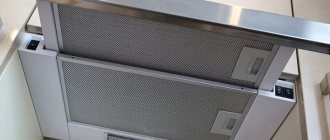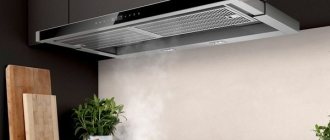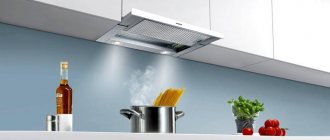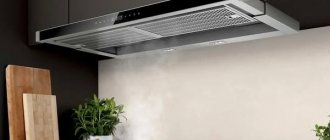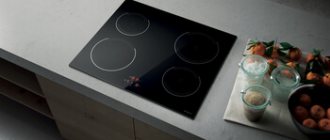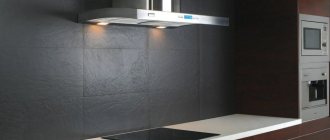If you love to cook, then a range hood is the kitchen appliance that you shouldn’t skimp on. There are several reasons for this. Firstly, built-in hoods, while remaining almost invisible, allow you to avoid the appearance of dirt on walls, ceilings, doors and other surfaces. Secondly, they quickly remove all unpleasant odors, especially if something is burnt on your hob.
The hood prevents the odors emitted by the stove from penetrating into neighboring rooms, as well as from permeating the clothes and hair of those present.
Types of hoods
Hoods can be industrial or domestic. Industrial ones are larger in size and are installed in food production facilities, restaurants, and canteens. Household ones are preferred for the home as their capabilities are limited.
Types of household models by installation type:
- Fireplace (dome) - so called because of their similarity to a conventional fireplace system. The principle of their operation boils down to the following - air enters the dome-shaped housing and is discharged through the air duct into the ventilation. Fireplace designs most often have a bright design and are distinguished by expensive finishes. And they need to be selected even before the kitchen is equipped with appliances. Depending on the location, there are wall, island and corner fireplace hoods.
- Suspended - their working area is equal to the area of the hob. They are characterized by a small height, which is why they are also called “flat”. They are mounted under the kitchen cabinet and flush with the adjacent ones so that their lower parts are in line. Such models are the most budget-friendly of all that are presented on the market.
- Built-in - they operate in flow mode, and therefore require an air duct. They can be mounted in the ceiling, in a table, in a closet so that only that part of the structure that absorbs air remains visible. Based on the type of installation in the cabinet, built-in appliances are divided into pull-out and fully built-in. The retractable one has a small panel that slides out and increases the fence area. Fully recessed is installed completely, without leaving visible elements. Ceiling - designed for installation in a niche, which is created by installing plasterboard slabs on the ceiling. Ceiling units are good because they are inconspicuous and take up minimal space.
Popular manufacturing brands
Based on the statistics of real demand and assessment of consumer preferences of buyers, it can be stated with certainty that of the entire variety of brands that are presented on the market, Russian buyers mainly prefer models of built-in hoods from such popular brands as Elikor , Krona , Cata , Hansa , JETAIR , Maunfeld .
In addition, over the past five years, one can trace an established trend - a significant part of the internal needs of the Russian market (47–53%) is absolutely provided by household appliances of domestic brands, and this applies to both traditional models and sophisticated and ultra-modern ones.
Criterias of choice
- Exhaust power. The volume of air that it can remove (or purify) per unit of time depends on the power of the hood. The calculation will be simple: according to sanitary standards, the hood must extract at least 10-12 m³/h. We calculate the volume of the kitchen space, multiply by 12, add a “reserve” of 20 percent and another 5%-10% if the kitchen uses gas rather than electricity - and we get what we are looking for. If you want to save money, you can subtract the volume occupied by furniture and a refrigerator. For example, a kitchen with an area of 10 square meters and a ceiling height of 3.2 meters will require a hood with a capacity of about 500 m³/h. Most hoods have several operating modes, which allows you to regulate the speed of the motor, and at the same time the volume of air passing through the device (and at the same time the noise level).
- Principle of operation. Recirculation without duct or exhaust with duct:
Circulation hood. This device received this name because it simply forces air to circulate throughout the room, eliminating foreign odors by passing it through a carbon filter, which is located inside the hood itself. In addition to the carbon filter, this hood is equipped with grease traps. The principle of its operation determines all the positive and negative aspects of such a design.
Pros of circulation hoods
- Possibility of use in houses with a clogged ventilation system or simply designed for low draft and cannot cope with the capabilities of modern hoods.
- Such a device can be placed anywhere and you do not have to pull the corrugation from the ventilation shaft to it. This also opens up wide possibilities for designers - such a hood can be hidden in a countertop or behind a false wall.
- When recirculating air, it is not necessary to create strong draft, which means the devices can be more compact and more economical in terms of energy consumption.
- With less load on the engine, which is the main component of the hood, the overall service life of the device increases.
- The location of the cooking plate is not tied to the ventilation shaft.
Disadvantages of circulation hoods
- The need to purchase consumables - depending on the intensity of use of the hood, carbon filters must be changed approximately every six months to a year.
- You will have to regularly wash the grease filter - it is a fine metal mesh that is installed at the bottom of the hood and cleaned in running water or in the dishwasher.
- There is no point in placing a circulation hood over a gas stove. During the combustion of gas, oxygen from the air is converted into carbon monoxide (CO²), which the hood will simply circulate around the kitchen. Recycling in this case becomes not only ineffective, but also hazardous to health.
Flow hood. The main difference of such a device is that for it to work effectively it definitely needs access to the ventilation shaft. The hood is mounted either directly next to its opening, or is connected to it with a corrugated pipe, which is made as short as possible - the smaller it is, the quieter the operation of the hood. For this reason, devices of this type are somewhat limited in their installation location - on the wall above the stove or on the ceiling. The principle of operation of the device is quite simple. The fan pumps air and draws it out of the room, forming a kind of draft that forms when the window is open, only the air does not spin around the kitchen, but is blown by the fan into the ventilation shaft or directly outside if a separate ventilation hole is made in the kitchen wall for the hood. Since dirty air is discharged outside, there is no need to use carbon filters, but to prevent particles of fat and soot from contaminating the insides of the hood itself, a grease filter is still installed on it. It must be washed periodically - the cleanliness of this part determines how efficiently and quietly the hood will work. Due to the need to install ventilation, it is better to install flow hoods during renovation work in the kitchen and, when planning it, separately calculate its location. Particular attention should be paid to the air duct - ideally it should be a straight line without bends or turns. If they are present, the air will hum strongly inside the pipe and using the hood will be at least uncomfortable. In general, based on the principle of operation, it is clear which hood for a gas stove is better - in this case, only a flow-through one should be installed. Almost all models of flow hoods can be started in recirculation mode - for this, a carbon filter is installed at the outlet and the device is ready for operation.
Advantages of flow hood
- The ability to make powerful, high-performance devices.
- There are no consumables that need systematic replacement - the grease filters used are almost eternal.
- The hood can be hidden in the kitchen furniture.
- The noise level is lower than that of circulating analogues.
Disadvantages of flow hood
- Since the hood essentially pumps air out of the kitchen, another must flow in its place, for which you need to leave the window open or think about ventilation also for air flow.
- A consequence of the previous drawback is that in winter the hood removes warm air from the room, replacing it with cold air, and in summer, vice versa.
- If the stove is (or will be installed) far from the ventilation hole, large-scale installation work is inevitable.
- Case design and material. The choice of the appearance of the hood is determined by two factors: the attractiveness of the design and ease of maintenance (everyday cleaning). There are many models on the market, so there is no doubt that every cook will be able to choose just the right hood that will look great in his kitchen. But cleaning can be difficult. Therefore, it is better not to choose hoods whose body is made of cheap heat-resistant plastic, and opt for enameled, or better yet, metal bodies, which will be more durable and easier to clean. The alternative in the form of tempered glass is visually attractive, but it is an expensive solution and not very convenient for everyday care.
- Dimensions. The value should be selected based on the dimensions of the hob. It is the width that determines how well the fumes generated from cooking will be captured. The dimensions of the hood should be slightly larger than the dimensions of the panel. On the market you can find devices with a width of 50 to 90 cm. Models with a side of 60 cm are standard and universal. They are suitable for most gas stoves and electric surfaces. The depth depends on the parameters of the furniture in which the device is mounted. There are several solutions.
- Narrow appliances with a retractable panel that increases coverage area.
- The device is equal in depth to the headset.
- An option with a depth less than that of a cabinet.
In kitchens where cooking is frequent and varied, the use of the first group of devices is more appropriate. But the second and third types are more appropriate if the process of cooking occurs periodically. If you install a copy that is smaller than necessary, then you will face negative consequences:
- the unit will not cope 100% with its task, and some of the odors and fumes will enter the living rooms;
- Oily deposits and moisture will settle on nearby walls, which can cause the furniture to change color and swell.
- Noise level. If you conduct a survey among housewives what they don’t like about the hood, then the majority, I’m sure, will answer – noise. A monotonous and loud hum is very annoying, so you need to pay special attention to this characteristic. The noise level directly depends on the throughput: the more powerful the unit, the louder it makes noise. The noise level should be no higher than 55 dB at “low” speed. In intensive mode, the volume can reach 60-65 dB, which is considered quite acceptable. After all, you need to turn on enhanced cleansing for a short time, so you can be patient for a little while. Higher values will no longer be comfortable. In addition, such volume causes vibrations that spread throughout the kitchen furniture.
- Control. The hood control can be mechanical or electronic (for example, touch). In the first case, switching operating modes and lighting systems is carried out using mechanical buttons, in the second - using an electronic system, often equipped with a display indicating the selected operating mode. The main advantages of the electronic control system (in addition to aesthetic ones) are the ability to set a timer for turning the hood on and off. More advanced models can automatically change their mode depending on the degree of air pollution, and some even allow remote control via a special remote control or smartphone. The need for the presence or absence of such functions remains at the discretion of the buyer. Additional (optional) modes include an intensive mode, in which the hood operates at maximum power for some time, after which it switches to one of the standard modes, and an interval mode, which involves periodically turning on the hood for a predetermined time. The controls for most hoods remain standard - understandable even to an inexperienced user. The lighting provided in most hoods will help illuminate the hob, and can also become an independent element of the interior. Most hoods use standard E14 bulbs, but due to the latest EU energy saving directives, all hoods will be switching to more energy efficient LED bulbs in the near future. If desired, you can choose a hood that allows you to adjust the light intensity or even allow directional lighting of a specific kitchen area. It is also worth mentioning hoods that are ready to work together with hobs. Naturally, compatibility here remains at the manufacturer level: it must be the same. Such hoods are, in fact, controlled by the hob itself: it decides which mode will be optimal at the moment, based on the use of its resources.
- Additional criteria
Automatic switching on is implemented by using special sensors that detect the start of the cooking process by monitoring temperature and humidity. When these indicators change, the sensors independently turn on the device and turn it off using the same principle.
Inclined shape - inclined devices are a type of fireplace models. Their workspace is at different angles. Thanks to their ergonomics, such units save work space and make the least noise.
Remote control – provides the ability to regulate the operation of equipment remotely, without the need to run to the control buttons every time;
Timer – allows you to set the time when you need to turn off the equipment or switch to another mode.
Types of fastening and installation of hoods
According to the type of fastening and installation, kitchen hoods are divided into:
- Fully built-in - installed in a wall cabinet or dome of a decorative fireplace dome, in rare cases on a work table in close proximity to the hob. They are equipped with a retractable or stationary bottom panel, which significantly increases the cross-sectional area of the air intake and makes it easier to control.
- Wall-mounted - with various options for mounting on the wall.
- Flat hanging - mounted under a wall cabinet or shelf above the stove.
- Corner - initially designed for operation in the corner area.
- Island - attached to the ceiling in the area of the so-called “island” (when a free-standing stove and work table are located in the middle of the kitchen and have free access from either side).
The best manufacturers of built-in hoods
- Elikor. A domestic company founded more than 20 years ago - in 1995 - specializes exclusively in kitchen hoods. Its assortment includes a large number of models for kitchens of various styles. According to company representatives, at the moment, every fifth hood sold in Russia has come off the ELIKOR assembly line.
- Jetair . The company, founded in the small Italian town of Ceretto in 1984, was one of the first to specialize in hoods. To date, the company is one of the leaders in this market, offering customers not only good quality, but also famous Italian design.
- Kronasteel . The German company, founded in 2001, is one of the youngest, but at the same time the most successful, judging by sales in recent years. Despite its European origin, the target market is Russia and the CIS countries. The high popularity is due to the large number of models and affordable prices.
- MAUNFELD. The only manufacturer on our list that develops and produces the entire range of kitchen appliances, and not just hoods. The company was founded, according to the information on the website, in 1998 in the UK. The variety of models available for purchase is truly amazing. The official website presents more than 500 (!) various modifications of hoods.
Principle of operation
All modern kitchen hoods work according to the following principle:
- Steam from the stove enters the inlet of the device. At the same time, it is absorbed not by the entire surface of the hood, but by narrow zones located along its perimeter. This method is used by many manufacturers, as it is effective and helps make the device body more compact.
- Models operating in air exhaust mode direct unpleasant odors into the ventilation shaft.
- Devices that provide recirculation pass air masses through a filter. The purified air flows back into the kitchen.
Most models can work in both modes.
Inexpensive built-in hoods
ELIKOR Integra 60 black / black
A popular range hood model from the budget category. Integra 60 is an excellent solution for small apartments. If for some reason you cannot connect the device to ventilation, then it can operate in circulation mode. The hood has a standard installation width of 60 cm and a simple design with one motor. The latter consumes 200 W when selecting the maximum of 2 speeds. Productivity in this case reaches 400 cubic meters per hour of operation, and the noise level is 55 dB. To the right of the retractable screen of the inexpensive ELIKOR hood there are buttons for selecting the speed and turning on the light, represented by a pair of light bulbs with a total power of 20 W.
Advantages
- low cost
- high-quality assembly
- ease of installation
- nice appearance
- efficiency
Flaws
- There is no carbon filter included
- rustic appearance
Weissgauff TEL 06 BL
Functional model – Weissgauff TEL 06 BL. Equipped with a liquid crystal display that displays absolutely all settings. The control is touch-sensitive, the filters are made of aluminum (which greatly simplifies their care). Very quiet - even with the intensive mode of the device, the noise level does not exceed 46 dB. A truly functional, reliable and high-quality built-in hood.
| P(W) | 206 |
| Productivity (m³/g) | 720 |
| Dimensions (cm) | 67.5x37x24.5 |
| Noise rating (dB) | 36-46 |
Kronasteel Kamilla Slim 2M 600 inox
Camilla is designed to be built into a closet and has a pull-out design. Like most of its classmates, the air purifier has compact dimensions - 18*60*28 cm. The installation width is 60 cm. The standard air duct is 120 mm. I'm sure there won't be any headaches with the installation. Silver color is also quite versatile and fits into any interior. We can safely praise the model for its build quality. The body is made of durable metal, a good fit is visible everywhere, nothing will rattle during operation. Air purification is carried out by two motors with a total power of 236 W. This gives decent performance at 550cc. With such equipment, fresh air will be provided in any kitchen. There are two operating modes - circulation and exhaust. You can change the speed of the machine at three speeds. In any case, you can count on quiet operation; the declared noise level does not exceed 48 dB. The whole thing is controlled by mechanical buttons. Lighting is halogen, the work surface is illuminated by two 28 W lamps. An anti-return valve works in conjunction with the hood. The kit includes a grease filter.
Advantages
- great build
- the most convenient control
- productive
- practically no noise
- convenient backlight
- price quality
Flaws
- No
GERMES Chester 60 IX
Among 60 cm wide hoods, it is difficult to find a model cheaper than GERMES Chester 60 IX. The characteristics of the built-in device are even more surprising. 3 operating speeds, a productivity of 600 cubic meters per hour and mechanical push-button control do an excellent job with their assigned duties. The silver body can be hidden in a cabinet, and the hood can be pulled out if necessary. A grease filter is included and can be washed in the dishwasher. Reviews note the ease of cleaning: parts are removed by pressing a button, the material does not attract dirt. Two 25 W incandescent lamps are built into the device body. The noise level reaches 47 dB, which does not interfere with a calm conversation in the kitchen. The user can set a timer, the time is counted down on the front panel display. The budget nature of the device is revealed only by the material: thin matte metal without edging. The manufacturer provides a 2-year warranty on the product and promises up to 60 months of uninterrupted operation.
LEX Hubble 500 Inox
The built-in hood LEX Hubble 500 Inox effectively copes with air purification in recirculation and exhaust mode. The unique advantage of the model is European production and low price. The Italian-style elegant design and thoughtful functionality are noticeable. The body is made of metal with stainless steel edging. The materials are easy to care for and dirt does not stick to them. The maximum productivity of 650 m³/h is enough for a kitchen of up to 14 square meters; air and odors do not have time to scatter throughout the room. Reviews warn that at high speed the built-in hood requires a lot of electricity: up to 102.5 W, which is not very economical. But they praise the noise level at 44 dB, the engine is almost inaudible. The model is only 50 cm wide and fits into narrow cabinets. Control is carried out by two mechanical toggle switches. Of the additional functions, only 2.5 W LED lamps are available.
How to choose and what to pay attention to
Built-in hoods are designed for installation in the body of a wall cabinet located directly above the hob.
Only a narrow panel with control buttons remains visible, so they do not spoil the look of the kitchen at all, and in most cases they even add a certain elegance to the atmosphere.
The operation of built-in models is rational in cases where the existing interior style excludes the presence of visible household appliances.
The following main indicators for choosing a kitchen hood can be noted:
- Productivity (cubic m/hour). This indicator indicates the ability of the hood to cope with the required functional tasks. In the passport of a household appliance, the manufacturer must indicate the area of the room for which the model is designed. Weak hoods are not able to properly carry out the processes of air exchange and exhaust. And more powerful ones, as a rule, are overpriced in terms of energy consumption and general feasibility.
- Power consumption and energy efficiency - in general, these are the two main criteria that should definitely be taken into account when purchasing a kitchen hood. It is worth considering that different household appliances can consume different amounts of electricity to remove the same volume of air.
- Noise level - the lower its value, the more comfortable the process of using the hood. Constant noise can be irritating. However, it is not yet possible to create completely silent or extremely quiet operating hood models. As a result, experts do not recommend purchasing a hood whose operating noise exceeds 70 dB.
- Operating modes . As a rule, there are two operating states for the hood - removing air from the room or recirculating air inside it. In the process of air removal, an air duct is attached to the hood, which must be purchased and installed separately. When recirculating, a ductless hood provides the opportunity to purify the air in the room. When using this mode, there is no need for an air duct, since it is not actually used, which is most economical in the cold season. Removing increased volumes of warm air is associated with additional costs for warming up the cold air coming from the street. Each individual mode has its own built-in filtration system.
- The design and design of hoods are presented in a huge variety: classic dome, fully built-in, wall-hung, canopy, etc. The color range is also quite wide and varied, allowing the device to fit as seamlessly as possible into any interior, regardless of style.
Premium built-in hoods
MAUNFELD CROSBY ROCKY 60 white
This device is produced by MAUNFELD, which has repeatedly proven its reliability and ability to create excellent kitchen appliances. The device is equipped with a 190 W motor. It can operate in 5 modes, providing a capacity of up to 750cc. m/hour. One of the main advantages of the CROSBY ROCKY 60 hood is its low noise level (up to 51 dB). We were also pleased with the lighting - two 3 W LED lamps, guaranteeing brightness and low power consumption.
Advantages
- filter screen
- clock control
- stylish appearance
- bright backlight
- air purification efficiency
Krona Kamilla 2M 600 black
The product Krona Kamilla 2M 600 black is a modern and reliable built-in model.
It is characterized by high performance and easy to use. The device also has air exhaust and circulation modes. In the first case, the air, along with smoke and other foreign odors, is removed from the room through the air duct to the outside. In the second case, the air is not removed from the room, but is cleaned by grease and carbon filters, and after cleaning, it flows back through special holes in the housing. The device has a three-stage power adjustment, which allows optimal consumption of electrical energy depending on air pollution, and the noise level complies with European standards. The product has two grease filters made of metal, which are easy to clean and do not require replacement. The carbon filter required for operation in circulation mode is not included in the kit and must be purchased separately. Characteristics :
Number of speeds - 3.
Number of engines - 2.
Noise level - 46 dB.
Advantages
- productive
- comfortable
- stylish design
Flaws
- incandescent lamps
- noisy at third speed
Bosch DFS 067K50
Luxury model of the famous German brand. The hood has a special retractable screen with a metal decorative panel. Grease filters can be washed in dishwashers. The device has a built-in unique EcoSensor sensor, designed to analyze the amount of incoming evaporation and select the required automatic mode.
| Power, W) | 180 |
| Productivity (m³/g) | 765 |
| Dimensions (cm) | 42.6x59.8x29 |
| Noise level (dB) | 41-54 |
Advantages
- EcoSensor selects the appropriate automatic mode
- intensive mode automatically turns off
- LED lighting
- touch control
- EcoSilenceDrive engine ensures quiet operation (less than 54 dB in normal mode)
- presence of a timer
- there is an intensive mode
Flaws
- no serious deficiencies found
Siemens LI 67SA530 IX
Electronic control, 3 power levels and one intensive mode, LED lighting - all the characteristics are at a high level, but the price is two times lower than that of luxury models.
| P(W) | 146 |
| Prod. (m³/g) | 740 |
| Dimensions (cm) | 43x60x29 |
| Noise (dB) | 43-55 |
Advantages
- Quiet operation (normal mode 43 dB)
- several power levels and intensive mode that turns on automatically
- electronic push-button control of the device
- German assembly, twin-engine design
Flaws
- no check valve
AKPO Neva wk-6 60 IX
Very powerful model with a capacity of up to 1050 m3/h. Compared to other 60 cm wide hoods, it has compact dimensions and more flexible settings. The manufacturer provides five operating speeds. When you turn on the hood, all unwanted odors quickly disappear. Two bright LED bulbs are used to illuminate the work surface. Among the pleasant aspects, equipment owners highlight the presence of an automatic shutdown timer and a control panel. The metal is dense, the build quality is excellent, the design uses a motor from an Italian manufacturer. The only significant drawback is that there are no carbon filters included. They need to be purchased separately, and they are not always on sale.
Comparative characteristics
During the cooking process, the air is filled with various odors, liquid evaporates, and fat is sprayed in different directions. To reduce health harm from carbon monoxide, it is recommended to install hoods.
| Name | Power consumption W | Maximum capacity m3 | Cost (rubles) | User rating |
| Weissgauff TEL 06 BL | 180 | 720 | 12999 | 5 |
| Kronasteel Kamilla Power 3Р 600 | 210 | 800 | 8599 | 5 |
| Bosch Serie 4 DFM 064 A 51 IX | 76 | 420 | 20990 | 4.9 |
| Maunfeld CROSBY LIGHT 60 | 190 | 850 | 7790 | 4.8 |
| Franke FTC 6032Wh | 125 | 510 | 6960 | 4.7 |
| Akpo NEVA WK-6 60 IX | 210 | 650 | 11990 | 4.7 |
| Shindo Maya 60 W/WG | 120 | 420 | 6390 | 4.5 |
| Maunfeld VS Light (C) 60 | 160 | 520 | 4990 | 4.4 |
| Elica Elibloc 9 LX SILVER F/60 | 240 | 900 | 6990 | 4.3 |
| Bosch DHI 642 EQ 60 WH | 160 | 420 | 6999 | 4.3 |
It is almost impossible to imagine a modern kitchen without a hood. We can talk about its benefits endlessly. With it, housewives will forget about the unpleasant smell, plaque, greasy stains and other problems.
Built-in kitchen hoods 60 cm
Konigin Insait Inox 60
Built-in cabinet hood with 1 motor, which produces a performance of more than 700 W.
There is a display, a timer and, in addition to touch, remote control via remote control. 2 LED lamps of 3 W each are used for lighting. The 60 cm wide model is ideal for a hi-tech kitchen due to its strict metal body, which is praised by its owners. An anti-return valve and a grease filter are provided. Specifications:
Control from anywhere in the kitchen
Country: Poland
Power: 170 W
Noise level: 30-51 dB
Capacity: up to 750 m3/h
Advantages
- Quiet operation with powerful cleaning
- Modern look
- Touch control level
Flaws
- Price
Bosch DHI645FTR
Retractable, with a housing and a metal grease filter that absorbs 89% of contaminants.
It can be cleaned in the dishwasher. For convenience, there are 3 power levels with different noise levels. It is possible to work with ventilation and recirculation, but in the second case the productivity will be no more than 220 m3/h. Despite the modest performance, reviews praise the device for its effectiveness in removing odor due to its special design and barely audible operation at 1-2 stages. Specifications:
Optimal for a kitchen of about 12 m3
Country: Germany
Power: 181 W
Noise level: 50-62 dB
Capacity: up to 300 m3/h
Advantages
- Pleasant halogen lighting
- Reliable filter
- Convenient performance adjustment
Flaws
- You cannot turn on the lighting without starting the air purification
- Noise level 3
Krona Mini 600 white
The Krona Mini 600 white hood is a fully built-in device and is required for installation in a wall cabinet. Thus, the user will save space and will not spoil the interior with a large structure. Only a small metal panel will remain visible, which will look appropriate with any kitchen design. An inconspicuous device will protect your home from unpleasant odors, smoke, fumes and remove grease particles that may settle on furniture. For this, the model offers two operating modes. The most popular is air exhaust. The engine sucks in fumes and smoke and discharges them into a common air duct. To prevent the exhaust air from returning back, an anti-return valve should be installed. A grease filter is responsible for purifying the air. Also, the hood helps cope with recirculation, returning purified air back. To do this, you need to additionally buy a carbon filter. With any of these options, you are guaranteed high performance and low noise levels that do not cause problems.
Characteristics:
Number of engines - 1.
Number of speeds - 3.
Power - 175 W.
Noise level - 46 dB.
Advantages
- Auto-off timer
- Removable frame
- Bright backlight
Flaws
- Noisy
- Replacement filters are hard to find
Elica Elibloc 9 LX SILVER F/60
Fully built-in air purifier, 28.9 cm deep, silver. Work is provided by two engines. Three speeds are switched using a slider. Capacity 500 cu.m. m/h. Lighting with two 28 W incandescent lamps. Power 256 W. Noise 63 dB.
Advantages
- reliable assembly
- good suction power
- low, takes up little space
- looks neat, not noticeable from the outside
- inexpensive
Flaws
- Can't cope with strong odors (fried fish)
- The bulbs get very hot, it is better to replace them
- some buyers indicate that not all the steam is drawn out
- average noise level
Elica FILO IX/A/60
Powerful three-speed extractor with a capacity in intensive mode of up to 800 m³/hour and electronic clock control. Can be set for circulation or diverter operation. Equipped with economical LED backlighting – 2 lamps of 3 Watt each.
Advantages
- Monolithic design with no moving parts - nothing to break
- After installation it is almost invisible - the panel is completely placed under the cabinet
- Low noise level - the hood can be heard only at third speed and in intensive mode
Flaws
- The mounting screws included in the kit have a star-shaped fastener - when purchasing, you need to make sure that there will be something to tighten them with.
- Cold light from backlights - many associate it with hospital lighting, but this is not for everyone
- If the diameter of the apartment ventilation is narrow, then the exhaust power may even be excessive. The ventilation hole on the device itself has a diameter of 150 mm - the outlet pipe must be made the same - otherwise it may affect the volume of operation
First of all, it is better to pay attention to such a hood for owners of studio apartments, with a minimalist design and a large kitchen area, which is usually combined with the living room. But before buying, you need to decide whether the ventilation capacity is enough for its operation.
How to install a hood in a closet? Instructions
Installation of built-in models proceeds according to the following scheme:
- The shelves and bottom are removed from the cabinet. Fasteners are installed to give the structure additional strength.
- On the removed parts, the places where the holes for the air duct and the housing will be located are marked.
- Holes are cut according to the markings.
- The hood is mounted in the cabinet so that the bottom edge is aligned with the bottom of the cabinet.
- The body is secured and the shelf is put in place.
- An air duct is installed and carefully passed through the hole made.
- The hood is connected to the network and its operation is tested at all power levels.
Built-in kitchen hoods 50 cm
ELIKOR Integra 50 white/white
The ELIKOR Integra 50 device is a classic product that is fixed inside the cabinet and saves space in the kitchen.
The device is easy to use: the choice between operating modes is carried out using switches equipped with clear markings. The design provides two programs: with low and high fan speeds. The model can be connected to the ventilation system and mounted above the surface of the stove. Thus, smoke and unpleasant odors that appear during cooking are captured and leave the apartment through a special pipe. The device is equipped with a grease trap in the form of a grate and made of metal, which allows you to retain oil splashes and prevent them from settling on the furniture. The part is removable and can be easily cleaned with hot running water and a soapy sponge. The device has a motor with a power of 200 W. It copes with smoke and has a capacity of 400 cubic meters per hour. This indicator is suitable for quickly restoring the microclimate in small kitchens. Specifications :
Number of speeds - 2.
Backlight power - 40 W.
Engines - 1.
Noise level - 55 dB.
Advantages
- Design
- Draw quality
- Beautiful steel strip
Flaws
- Noisy
- Flimsy design
LEX Hubble 500 White
White hood 28 cm deep. Two extraction speeds are switched by buttons. Capacity 570 cubic meters/hour. Lighting is provided by a 2.5 W LED lamp. Power 103 W (motor 100 W). Noise 48 dB. Weight 6 kg.
Advantages
- nice view
- sliding panel
- removes heat and odors normally
- simple controls
Flaws
- one light bulb
- noisy at high speed
- no turbo mode
MAUNFELD Crosby Push (2m) 50 stainless steel
The width of the hood is 50 cm, the diameter of the air duct is 120 mm. I will immediately note the high-quality metal case. The assembly is correct and competent - this model does not rattle during professional installation. The color scheme is universal – silver. Two engines with a total power of 190 W work inside. At the output, they produce a capacity of 750 cubic meters per hour, which is suitable for both medium and large kitchens. Unpleasant odors will be removed quickly and without problems. Count on two modes of operation (recirculation and exhaust) and three speeds. At maximum, the device will “whisper” at 52 dB. The model is mounted on mechanical control. The machine receives commands using buttons. Comfortable lighting will add convenience. These are two powerful halogen lamps. Replacement of burnt-out consumables is carried out in seconds. The kit includes a grease filter.
Advantages
- good build
- convenient installation
- strong management
- efficiency
- silence
- affordable price tag
Flaws
- No
JETAIR AURORA LX 50 WH
JETAIR AURORA receives the nomination “The smallest and neatest built-in hood” in our rating. Indeed, compared to other models with a width of 50 centimeters, this device looks much more compact. It works quietly but effectively - this product can easily become a favorite in your kitchen.
| P(W) | 206 |
| Productivity (m³/g) | 650 |
| Dimensions (cm) | 49x19x46 |
| Noise rating (dB) | 46-53 |
Advantages
- quiet operation (no more than 53 dB even in intensive mode)
- beautiful appearance
- nice lighting
- minimum dimensions (49x19x46 cm)
- the hood has a standard cartridge that is easy to change
- built-in dirt indicator
Flaws
- not found
Advantages and disadvantages
The main advantage of a built-in hood is that it is either completely hidden from view or reliably camouflaged. The advantages and disadvantages of the devices are described in the table:
| pros | Minuses |
| Aesthetic appearance - the device seems to be in the kitchen, but at the same time, it is carefully hidden from prying eyes. | Low power |
| Compactness - such hoods are characterized by their small size in comparison with other types. | Difficulty of installation |
| Low noise level - due to the fact that the device is built into a wall cabinet, it dampens vibrations and reduces noise. | |
| Functionality - despite its compactness, the device is no different in function and performance from other types. |
It is worth noting that such models are much cheaper than other types of hoods.
Hanging kitchen hood
Gorenje DU 5345 W
The operation of the hood is ensured by a three-speed electric motor - despite its size, the device has a productivity of up to 300 m³/hour, which is quite enough to clean the air in a kitchen with an area of up to 10 m². Modes are controlled and lighting is turned on using buttons on the front panel.
Advantages
- Ease of Management. There is a button for the backlight and each speed.
- Easy installation - the hood is screwed in with dowels, after which all that remains is to close the lid
- Little weight
- Ability to operate in air exhaust and air circulation modes
- Price-quality ratio
Flaws
- Thin metal body. It does not affect the work, but there is a general feeling of “flimsy” design. In some devices, you may feel the panel pressing down
- At high speeds there is a noticeable noise from the air in the housing and corrugated pipes
- There is no chassis grounding. But the motor is in a plastic case and is not in contact with the hood body
- Energy efficiency class "E"
Dimensions and type of hood control
The width and depth of the coverage area (cm) is the correct choice of hood when the geometric dimensions completely coincide or slightly overlap the dimensions of the slab. And the effective distance between the hood itself and the hob for electric stoves should be at least 70 cm, for gas stoves - 80 cm.
Control – mechanical (push-button or slider) or electronic (touch). The first option is the simplest, cheapest and most common. However, the “mechanics” are susceptible to contamination and sticking over time. Electronic ones are more stylish and modern, and the presence of a microprocessor and an indication display allows you to implement additional options: (See also: How to choose a 50 cm kitchen hood)
- automatic control of operating modes, turning on and off using timers and sensors that respond to the temperature of the hob and air humidity;
- control and indication of filter contamination status;
- remote control using remote control.
How to choose a hood design according to the type of installation
Having decided on the type of device, you need to choose the most suitable hood design. It is important that it fits harmoniously into the interior of the kitchen, since modern manufacturers offer a huge selection of models. After all, the internal structure of any kitchen hood is the same, and the main differences are engine power, build quality, and lighting of the work area.
Hanging
These are mainly budget models of devices that are distinguished by low engine power, but have their own advantage - low energy consumption. Regardless of the manufacturer, such hoods have standard body dimensions of 60x50x15, where a grease filter is located at the bottom and the motor is located inside. They are easy to install and operate.
Despite the low price, this category offers very reliable air purification devices that are almost silent in operation. The best hoods for the kitchen must include hanging models in their catalog.
Dome
Due to the peculiarity of their design, they are also called fireplace ones. Outwardly, they resemble the ventilation system of natural fireplaces and immediately attract attention in the kitchen. Based on this feature, fireplace hoods are presented in a huge range of different designs, styles and colors. These models are equipped with a powerful engine that provides powerful traction and greater performance.
According to the design, dome hoods are divided into three types:
- Wall-mounted. They are mounted on one of the walls, for this purpose the back side is made flat.
- Angular. They have the shape necessary for installation in the corner of the kitchen.
- Island. They are attached to the ceiling, and quite often in such cases a ventilation pipe is passed through it. This is especially easy to do if suspended plasterboard ceilings are installed. An island hood can be installed and used only in a kitchen with a large area where the stove is in the middle of the room.
Built-in
After installation, such hoods become almost invisible - only the control panel with touch or mechanical buttons remains visible. Usually it is a narrow strip several centimeters high - black, white or silver.
Such kitchen hoods can be built into kitchen cabinets above the stove or countertops - in the first case they extend in a horizontal plane, and in the second (such models are also called “dominos”) – in a vertical plane.
Corner and wall-mounted devices can have an inclined working surface - this improves their appearance and also reduces the likelihood of hitting the edge of a conventional hood with your head.
What parameters should you use to select a hood?
So, how to choose the right hood? How to avoid making mistakes and not being disappointed with your purchase? Everything is simple - you just need to take into account a few basic rules and know a number of parameters and characteristics that you need to pay attention to when choosing the optimal model.
Large hood, very conspicuous
Dimensions and design features
Let's start with the sizes. This is perhaps one of the main parameters, especially when it comes to a built-in model. It is optimal if the width of the hood matches and perfectly matches the width of the work surface above which it will be mounted. then the efficiency of the device will be maximum. That is, the hood dome must completely cover the entire hob or the upper part of the stove. It may be a little wider, but not narrower than the hob!
Advice! For hob surfaces with a width of 45-60 cm, you should purchase a hood just 60 cm wide.
Next, you should select the type of hood. The chosen option should suit the overall style of the kitchen and also be convenient to use. In a small kitchen, therefore, you need to buy a small hood. Just built-in or hanging are excellent options that will not look bulky and harmonious. But it’s better to refuse the fireplace. For a large kitchen, you can choose any model, even the largest, as long as you like it and fit the overall style.
Well-built hood
Advice! If you don’t want the hood to be noticeable, it’s best to buy a built-in model of small dimensions.
If we talk about the materials from which hoods are made, the most commonly used are metal, glass and plastic. There are also hoods made of steel. Steel models are the most difficult to maintain, as hard-to-remove stains quickly appear on them. Even more capricious is glass, which not only gets dirty even from accidental touches, but is also very difficult to clean. But it looks, we must pay tribute, very beautiful.
The most inexpensive hoods are made of aluminum. They are quite easy to care for. But they look cheap and, as a rule, do not have an interesting design.
Air removal method and filtration
According to the method of exhaust hood, as we said, there are recirculation and flow-through. The choice between models of one type or another largely depends on how the ventilation is located in the kitchen and what kind of stove is used. So, for gas stoves you can only buy a flow-through version, otherwise combustion products will still enter the room, passing through all the filters, and will begin to poison the air you breathe. But for a regular electric oven, you can buy a model of one or the other type. You can also take a combined option, which includes air purification using filters or direct air removal from the apartment.
If it is possible to connect the exhaust to the ventilation, then it is best to organize direct exhaust of air from the house. But in this case, it is important that the ventilation hole is located close to the hood. The shorter the corrugated line, the less noise the hood will make during operation, and it will work more efficiently.
Built-in hood connected to the ventilation shaft
On a note! The performance of models with recirculation is noticeably lower than that of options with flow-through air exhaust.
If we talk about the filtration system, it is important that the filters inside the hood are good. Absolutely any model must have a grease filter, which simply needs to be cleaned regularly (made of metal) or replaced (made of non-woven material). Some are dishwasher safe. Sometimes there are options for hoods with grease traps of both types.
Also, in recirculation type models there is always a carbon filter. It absorbs odors, as well as small particles that pollute the air. Such filters need to be regularly replaced with new ones, since if they are heavily soiled, they become ineffective and the hood stops working.
Performance
The most important thing in a hood is good power and performance. When choosing a model, you should pay great attention to these parameters. Thus, the description and instructions for any model usually indicate the recommended dimensions of the rooms in which the selected option can be installed.
You can calculate the optimal performance yourself. So, the hood should process all the air in the kitchen at least 12 times within an hour. So productivity can be determined by multiplying the area of the kitchen by its height and multiplying the resulting value again by 12. This way you can get the recommended productivity value. If there is air exhaust into the ventilation shaft, then you need to additionally multiply the performance by a special coefficient of 0.3 (resistance in the air duct).
The air mass renewal factor can be equal to 15. If the oven is gas type, then it needs to be increased to 20.
Hood performance calculation
In short, the performance characteristic of a particular model should not be less than the resulting number. But strong excess is also not recommended, since powerful hoods produce a lot of unnecessary noise.
On a note! The productivity of hoods of different types and models can vary between 100-2000 cubic meters per hour.
By the way, it is best to always increase the calculated performance value by at least 10%. For example, in case of smoke in the kitchen, a hood with a little more power can easily solve the problem. Also, performance is always taken with a margin if a flow-through air exhaust system is installed, especially a long or winding one. Here for each meter you need to add approximately 10% of the calculated performance indicator.
Other functions
In addition to all of the above, there are several more aspects that need to be taken into account when choosing a hood. So, for example, you need to look at what kind of control a particular model will have. It comes in several types.
- Touch - in this case, you can set a program or even just turn on the hood by simply touching the desired button with your finger.
- Mechanical or push-button is the standard option that is most common. Here you either need to press the usual familiar button or turn the lever to turn the product on or off. There are more buttons than the touch version, and each of them corresponds to a specific action.
- Pseudo-sensory or slider - an option with a mechanical slider. You just need to set it to a certain mode, and the hood will begin to perform its functions.
- Remote - control using a remote control.
Advice! It’s better to give up sliders and choose a hood with buttons or sensors. They are more reliable and convenient.
Built-in hood with lighting
Some modern options may have filter contamination sensors. A very convenient function that will remind you in time that it’s time to update or clean the filter inside.
Backlighting is not mandatory, but an important element. Its presence will allow you to illuminate the work area, and at night you can use the illumination as a night light if you need to go into the kitchen and do something, but you don’t want to turn on the light.
Speed limits are also an important parameter, but not mandatory. Simple hoods with one speed mode do not cope with their tasks much worse than those that have several modes. This is an important parameter for very powerful devices, and not for weak ones.
The noise made by the hood during operation can create discomfort when using it. But in reality, not many people pay attention to this indicator when purchasing this or that option. But in fact, you should find out in advance how noisy the hood is during operation. Especially if you have to spend a lot of time in the kitchen at the stove every day. It is better to take the quietest option possible.
Important! Powerful hoods are always noisy. There are no silent options among them.

